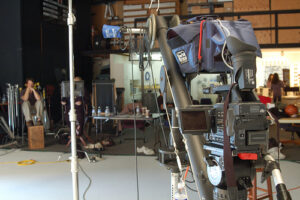Today I asked National Emmy nominated writer and producer Sydnye White to give us some of the basics on shooting in HD. Sydnye’s credits include the series Home Made Simple for TLC and Moneywise with Kelvin Boston for PBS. Her documentaries include Great Books: The Autobiography of Malcolm X for The Learning Channel and the Discovery Channel’s Detroit SWAT.
HD Primer by Sydnye White
So you have to shoot in High Definition and you don’t know where to start. Don’t worry. Though it may seem confusing at the beginning, knowing what to ask is half the battle. Here are a few questions to help you get started.
1. What type of editing intake system will you be using? There are many types of HD record options (HDCam, HDV-HD, XDcam, etc.) and decks to go with each. It is important to know how your edit system will acquire the footage so you can start out with the correct recording format. If you don’t know where you will edit or what type of system you are using, you can consider using a camera that records onto a disk. Later, you can then transfer the footage onto a hard drive or straight into the appropriate editing program.
2. What type of footage does your network, client or distributor accept? Some networks won’t accept some formats or minimal footage must come from it. For example, they may allow a given HD project to have up to 15% standard definition footage.
3. Will you be required to deliver all of the raw footage and if so, in what format? If the client wants raw footage in a certain format like HDCam, it makes sense to go ahead and shoot with that format. If you don’t have to turn over your raw footage, consider how you will archive the footage once your project is complete.
4. What are resolution and frame rate requirements? Most of the projects that I work on are shot at 1080i or 720i. Will your final project been show full screen? Do you have to downconvert to standard definition and if so, will it be centercut, anamorphic or letter boxed? You’ll want to make sure that the camera being used has the proper settings available and that the tapes and edit system can accommodate your needs.
It is important to talk to as many people as possible about your project until you feel comfortable making choice. Talk to shooters, editors and distributers/networks/clients. Sometimes there may be more than one solution to your HD needs. But armed with the right information, you can make the best decision for your project. Good luck.
Visit Sydnye White’s website at www.docsandtv.com




Great list of points! Especially if you’re going to be delivering to a network.
For instance, at VH1, for Scream Queens, we’re shooting and delivering SD. Looked into HD, but VH1 does not want to broadcast 16:9, and it’s an SD network anyway. While we could gain some color space for online coloring, at the end of the day it’s not worth the pain of shooting 16:9 while making the cam ops frame for 4:3. Or all the added disk space/workflow adjustments we’d need in post.
Thanks for putting this together!
Biagio
twitter: @jokeandbiagio